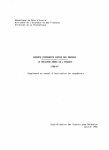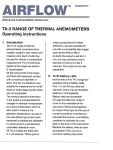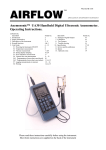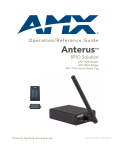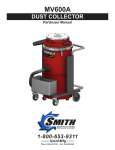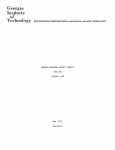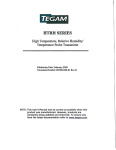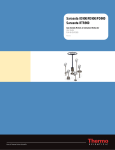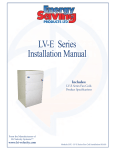Download TA4 THERMAL ANEMOMETER OPERATING INSTRUCTIONS
Transcript
TA4 THERMAL OPERATING ANEMOMETER INSTRUCTIONS Please read these instructions carefully before using the instrument Shortform instructions are on the back of the instrument. . INTRODUCTION. The TA4 is a battery powered,hand held instrument with a digital LCD display capable of measuring the velocity, volume flowrate and temperature of air by means of a thermal probe.The unit allows the airstream area to be entered for volume measurement. Measurements may be displayed in either Metric or Imperial units as selected from the keyboard.After selection,this will be 'remembered' by the instrument until reselected from the keyboard. The attached thermal anemometer probe has a tip diameter of Bmm and is, therefore, suitable for measurements at grilles, slot diffusers and in small ducts where large access holes are not acceptable. The velocity sensor in the probe is compensated for variations in airstream temperature by means of a second thermistor which also senses,and displays,the actual airstream temperature in either metric or imperial units consistent with the units selected for velocity. 2. BATTERY INFORMATION. The TA4 instrument is supplied without battery cells fitted.Four 1.5 volt AA size cells are required which may be either disposable or rechargeable types. Either 'Standard' or Alkaline disposable cells may be used but the 'Standard' type will exhibit a relatively short life and are,therefore,not recommended. Low battery condition is indicated by 'LOBAT' appearing on the instrument display. The cells must be replaced as soon as possible to maintain optimum accuracy. The battery cells are accessible by means of the slide and 'snap in' cover at the rear of the instrument case. To remove the battery cover,press firmly on the cover and slide it in the direction of the arrow. A tape is now fitted in the battery compartment to ease the removal of the battery cells and the use of a small screwdriver will also assist. Ensure that the battery cells are replaced with the correct polarity as indicated by the diagram in each cell compartment. Rotate the cell slightly forwards and backwards to check that the cell is properly seated in the cell compartment. 3 DESCRIPTION OF THE INSTRUMENT. (Refer to FIG.1 ) 3.1 Instrument 3.2 Keypad area 3.2 ON/OFF slide switch. On powering up,initially all the display segments will be shown briefly on the display,followed by a countdown from 9 down to 1. The display will then indicate either velocity or volume flow and temperature of the probe in the units previously selected. case This key sequentially selects on each key press either velocity, volume or area display modes. vel vol area ) This is a dual function key. In either Velocity or Volume modes, this key allows the units to be changed sequentially between Metric and Imperial on each key " press. In Area mode;the lower case option is selected which allows the VM area + airstream area to be incremented on each key press or by holding the key down. The rate of change of duct area will progressively increase the longer this key is held down. ] r zero area , - This is a dual function key. After power up initialisation, or when either Velocity or Volume flow modes have been selected, this key allows the unit to be zeroed (see section 4.3). In Area mode this key allows the airstream area to be decremented on each key press or by holding the key down. The rate of change of the duct area will progressively increase the longer the key is held down. 3.3 Display. All the character segments,as shown,will be displayed briefly after the unit is switched ON. Battery cover. This slides and 'snaps in' at the rear of the case. Telescopic probe and cable. The telescopic probe gives an extended length of about gOOmm. With the coiled cable fully extended, the maximum reach from the instrument case is approximately 2 metres. 3.6 Direction of flow indicator. Align with the arrow head on the probe cap Velocity measuring thermistor. 3.8 Compensating 3.9 Zeroing cap for velocity sensor. Direction and temperature of flow arrow measuring thermistor. Range O -800C. head on end of probe. 4 USING THE INSTRUMENT. 4.1 Switch ON the instrument. 4.2 Check battery 4.3 Zero the instrument. With the zeroing cap covering the velocity thermistor to isolate it from any air movement, press 'zero'. When zeroed the display 'press zero' will disappear. For optimum accuracy it is necessary for the instrument to be rezeroed with the probe at the operating temperature and zero velocity. 4.4 At switch on,either which was selected for LOBAT (low battery) on the display. If necessary,change cells before taking measurements. Refer to section 2. other,press the Metric or Imperial units will be displayed depending upon when last used.To change the units from one to the the 'I/M' switch. 4.5 To set a duct area,press the 'vel /vol /area' switch sequentially until 'area' is displayed,followed by its current setting in either m2 or ft2 (depending upon the units previously selected for velocity/volume). Area units are automatically converted when using the 'I / M' switch. Increment or decrement the area to its required value by means of the 'area +' or 'area -, key. Note that holding either of these keys down will increment or decrement the duct area at an increasing rate dependent upon how long the key is held down. Reselect velocity or volume flowrate mode by means of the 'Vel/ Vol / Area' key. 4.6 Extend the telescopic probe axially by pulling on the smallest section, taking care not to damage or stress the probe tip and ensure that the cable slides freely into the handle end of the probe. Remove the zeroing cap and ensure that the 'direction of flow indicator' on the probe handle is aligned with the 'flow arrow' on the probe cap. Offer the probe head into the airstream pointing the arrow (or 'direction of flow indicator' if the head is inside a duct) into the airstream in the direction of flow and read the velocity and temperature of the airstream. 4.7 To use the probe inside ducting a 9.5mm (3/8") diameter minimum hole is required in the duct wall. 4.8 If a duct traverse is required, it may help to use the joints between the telescopic tubes as markers to determine the probe head position. 4.9 When closing down the the telescopic freely back through the probe. 4.10 Always 5 WHERE TO USE THE INSTRUMENT. 5 Checking the air velocity or volume flowrate over large areas. When measuring velocity or volume flowrate over a large area, a number of readings must be taken,spaced to give an even coverage of the whole area. The average of these readings will give the mean velocity over the whole area or the mean volume flowrate.lt should be noted that quite large variations in readings may be observed and, in general,the larger the number of readings taken,the more accurate the mean velocity or the mean volume flowrate will be. The mean velocity or mean volume flowrate = the sum of all the readings taken the number of readings taken switch probe, ensure that the cable slides OFF when not in use to extend battery life 5.2 Use on grilles. Avoid intrusion of the arm and hand into the face area of the grille. The blockage effect would cause artificially high velocity over the remainder of the grille,leading to incorrect readings. The telescopic probe can be useful in avoiding this problem. Better measuring conditions can be obtained on grilles with adjustable direction vanes if the vanes are temporarily straightened before taking measurements. This should not significantly affect the flowrate so long as any built-in dampers are not accidently disturbed. The instrument is suitable for both supply and extract grilles, and the procedure is the same for both. 6. POSSIBLE SOURCE OF ERRORS. The above method ignores the effects of the reduced velocity at the duct walls. A more precise method is shown in BS1042 Part 2 -the Log Tchebycheff method. The positions for siting the probe for circular or rectangular ducts or apertures is shown in the following figures:- 02350 c 1-°.437D ~ ~ 05630 00 07650 09390 PosrtK>nof alternative measuring points and traverse lines relative to side lengths for rectangular ducts The previous procedure is satisfactory for use in ducts and unobstructed apertures, however significant errors may occur if the aperture is covered by a grille, particularly if this is of the type having adjustable direction vanes or dampers. The airstream issuing from such a grille is invariably very disturbed, consisting of many small areas of high velocity interspersed with areas of low velocity. The transitions between these areas are highly turbulent and there may even be some reversed flow. If maximum accuracy is required,it is advisable to make up a short length of test ducting which is just larger than the overall dimensions of the grille. This duct can be of any convenient rigid material ( such as ~tiff cardboard) and it should have a length of about twice the diagonal measurement of the grille. The duct should be placed over the grille, and sealed to the wall with adhesive tape. Measurements of flow can now be conducted, as already described, at the unobstructed end of the test duct. Ensure that the cross-sectional area of the ~ (not the grille) is entered in the TA4. 7, CHECKING THE INSTRUMENT. The TA4 instrument is provided with a SELF TEST routine, called HELP and a CALIBRATION routine which may be accessed from the SETUP mode. The calibration is a pushbutton procedure, with the calibration data being stored in non-volatile memory. Calibration is in metric units only. For optimum accuracy, perform a Temperature calibration prior to a Velocity calibration. 7.1 SETUP Mode. The SETUP mode is entered as follows:With the instrument switched OFF: Hold down any key while switching the instrument ON. The following messages will be sequentially displayed: SETUP then: V *.* (This is the instrument's software version number,which may change) then: Code. 7.2 Function Code. The code entered at this point will govern which SETUP function is chosen. Assuming that the keys are numbered as follows:Top key = 1 , middle key = 2 and bottom key = 3, then the function key codes are as given in the following table:- rcooE" lPURPOSE FUNCTION 21132 Calibration 11332 HELP routine mode Push button calibration of temperature or velocity. To assist in fault diagnosis. Each code keypress must be made within 15 seconds of each other or the instrument will revert to its normal 'read' mode. Each valid key press will result in a 'segment bar' appearing at the bottom of the display. If a non-valid code is entered, the instrument will revert to its normal 'read' mode. 7.3 HELP Routine. ( Code 11332). The unit will display 'HELP' for a period of two seconds,and will then display all the display segments as shown in section 3.3 ,with' Press Zero' shown flashing: check that all the display segments are present. Pressing the 'Zero' key will move the unit through a series of internal tests. The unit will display 'PASS' if it is functioning satisfactorily or display an error message if a test has failed. The significance of each error message is as follows:- 'Lobat' Low battery condition,or fault in low battery circuitry. The HELP routine will not proceed while this prevails. Change the batteries and retry. 'Error 1, * The eeprom 'Error 2' * The reference oscillator Service 7.4 if either voltage function is not is incorrect satisfactory. or the internal is faulty. The probe is missing or incorrectly connected. 'Error 3' * Note: read/write of these Department two messages appear,please contact Airfow immediately. Calibration routine (Function code 21132 entered) The instrument will display: 'CAL': TEMPERATURE Calibration Routine. Specialised equipment is required for temperature calibration, for information please contact Airflow Developments Limited, Airflow Lufttechnik GmbH or Airflow Technical Products Inc.. VELOCITY Calibration Routine. For velocity calibration, a stable air flow is required with a setting resolution of +/- 0.2% of reading and a velocity accuracy better than +/-0.5% of reading. Airflow can supply an Open Jet Wind Tunnel together with associated instrumentation suitable for this purpose, please contact Airflow Sales Department for details. To select VELOCITY calibration press key1 . 1) On entry to the velocity calibration routine, '00.00 m/s' will be displayed and a counter which decrements from '9' down to '0'. The unit will ignore any keypress while the counter is displayed. To set the zero for optimum performance, it is preferable that the probe tip is totally enclosed in a container, rather than the Zeroing Cap, to shield the probe tip from surrounding draughts. Allow 20 to 30 seconds for the probe tip to fully stabilise to the temperature of the air inside the container. Press Key 2 (zero key): the instrument will enter the input as the zero calibration point and will then display '5.00 m/s'. 2) Place the probe tip in an air stream set to a velocity of precisely 5.00 m/s and allow at least 10 seconds for the probe to stabilise to this condition. Press key 2: the instrument will enter this as calibration data and then display '10.00 m/s'. 3) Set the air stream velocity to 10.00 m/s precisely, allow 10 seconds to stabilise, press key 2 and the instrument will then display '20.00 m/s'. 4) Set the air stream velocity to 20.00 m/s precisely, allow 10 seconds to stabilise, press key 2 and the instrument will then display '30.00 m/s'. 5) Set the air stream velocity to 30.00 m/s precisely. allow 10 seconds to stabilise, press key 2 and the instrument will then display 'Gal end'. The velocity calibration is now complete, press key 2 to return to normal 'read mode'. A calibration accuracy check may now be performed, if required. WARNING: ALTERING THE CALIBRATION WILL INVALIDATE AIRFLOW'S RESPONSIBILITY FOR CALIBRATION UNDER WARRANTY. The unit monitors each time the calibration is effected. If the calibration routine is inadvertently entered then ABORT immediately by switching the instrument OFF and then retry. 8. SERVICE AND RECALIBRATION. If a fault or the instrument's calibration is suspected, it should be returned to Airflow Developments for repair or recalibration to original standards. In any event, it is good practice to have the instrument checked at least once a year. If an instrument is not working correctly or requires recalibration, contact your nearest Airflow Agent or U.K. Service Department on High Wycombe (01494) 525252 (International: +441494525252). Airflow Developments operate an Instrument Hire Service for the convenience of customers having equipment repaired or recalibrated. If you intend to take advantage of this facility please contact our service department to make arrangements prior to returning your instrument. 9. SPECIFICATION PARAMETER Velocity METRIC 0 -30 Range Accuracy* mlsec +1- 3% of reading +1- 1 digit or +1- 0.06 mls +1- 1 digit whichever Volume Flow is the greater 3 m Isec Range 0- 2,700 Accuracy* +1- 3% of reading +1- (0.06 x input Area) +1- 1 digit whichever I Temperature Range I ~~~~:~ature ~~;~~cy Qreater o 0-80C o +1- 1 C +1- 1 digit Airflow Range 0.008 Operating (Indicator Storage m31sec is the 2 Area Ambient 0- 999,999 +1- 1 digit or m o Temperature unit). -90 +1- 1 digit or +1- (12 x input Area) ft31min +1- 1 digit whichever is the Qreater o 176 F 0 +1- 2 F +1- 1 digit 32- 0.08 -900 ft2 0 -10to+50C 14 to 122 F O -20 to + 60 C o -4 to + 140 F 185 x 92 x 30mm 7.25 x 3.62 x 1 .25 in 360 gm. 12.7 OZ. ! Temperature ft31min +1- 3% of reading Four 1.5 volt AA type Alkaline,Standard or Rechargeable cells. Approximately 15 hours using Alkaline battery cells. * Accuracy CE Marking: is at ambient conditions of 20 oC and 1013 mb (68 oF and 30 in. Hg.) The unit complies with the EEC Directive on Electromagnetic Compatibility (EMC) 89/336/EEC. Applied Harmonised Standards: EN50081-1 Radiated Emissions and EN50082-1 Radiated and ESD Immunities. The statements and opinions contained in this document are made and expressed in good faith. Whilst every effort has been made to provide reliable information, Airflow Developments Limited do not hold themselves responsible for possible errors of an editorial or other nature, however caused. Should you require a more detailed specification for a product described herein, please contact our Sales Department. In view of our continuous programme of improvement we reserve the right to change AIRFLOW DEVELOPMENTS LIMITED, L.ancaster Road, Cressex Business Park, High Wycombe, Buckingham5hire HP12 30P, England Telephone: (01494) 525252/443821. Facsimile: (01494) 461073. E-mail: [email protected] WWW: http://www.airflow.co.uk/airflow AIRFLOW LumEcHNIK GmbH., Postfach 1208, D53349, Rheinbach, Germany. Telefon: 02226-9205.0. Telefax: 02226-9205-11. AIRFLOW TECHNICAL PRODUCTS inc., 23 Railroad Avenue, Netcong, N.J. 07857 USA. Telephone: 201-691-4825. Fax: 201-691-4703. AIRFLOW LUFTTECHNIK GmbH, 0.5. Praha, HostynskA 520, 108 00 Praha 10- Malesice, Czech republic. Telefon a fax 02-772230










